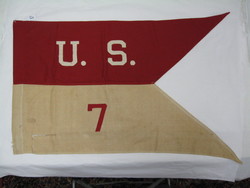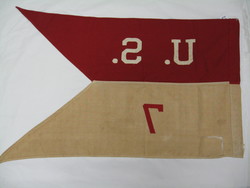U.S. Army Red over White Guidon, 7th US Cavalry - TV prop, Have Gun Will Travel, "Comanche", 1959.
This guidon is, to borrow a phrase from Winston Churchill, "a riddle, wrapped in a mystery, inside an enigma."
The riddle: what is it?
The mystery: why was it made?
The enigma: how was it used?
In the United States Army a guidon is a flag that a company carries to signify its unit designation and corps affiliation. A basic U.S. cavalry guidon is rectangular with a wedge-shaped slice cut out, leaving a "swallow-tailed" appearance. The name guidon dates back to the Middle Ages when a company of French dragoons would often use a small flag to guide men or "guide hommes." This became the English "guide upon" and, ultimately, "guidon." When the U.S. Army reauthorized a mounted service in 1833, its guidons followed the design of the pennants made famous by Polish lancers during the Napoleonic Wars: a red upper half above a white lower half. The guidon is a source of both identity and pride for the unit it represents.
At first glance this guidon looks like one of the 27" x 41" U.S. Cavalry guidons used from 1885 to 1931. However, this cannot be true because, even though the size is right, it fails to conform to the likes of those guidons in several ways. First, the "7" designating the 7th Cavalry regiment belongs in the upper half rather than the lower, where we ought to see a letter designating a troop within the regiment. This guidon is also made from cotton, instead of silk or wool, and it has been stitched on a zigzag machine with synthetic thread.
Unfortunately, knowing what something is not doesn't necessarily tell us what it is. So what is this object? We can begin to unlock its secrets by turning away from actual historical events to consider how we imagine history.
Around the world, perhaps no other martial image-maybe even no other image, period-can compete with the romantic sentiments awakened by the mounted horseman. In the United States, the Cavalry is central to the American West's mythic tradition. Whether it is right or wrong, this tradition portrays the Cavalry's mounted men as those who embody the heroism needed to sustain every other form of good in a hostile environment. The tradition pictures them proudly and alertly upright on their mounts, the sun at their backs, guidons streaming, carbines and sabers poised, riding with swift composure to rescue the besieged or beleaguered in the nick of time.
Nothing has done more to embed the Cavalry's romantic image in American popular culture than several decades of cinema. John Ford's archetypal 1939 film Stagecoach, which made John Wayne a star, tells the story of a stagecoach traveling "on the last frontier of wickedness," according to a colorful poster for the movie. We hear how "that old Apache butcher Geronimo" has his people on the warpath-and what a terrifying people they are! These Apaches are not so much human beings as irresistible forces of nature: wordless, lacking the individual personalities of the white characters which the filmmaker has drawn with such care, and single-mindedly devoted to slaughter. The Apaches surround the stagecoach but, as its passengers run out of ammunition, water, and hope, the horse soldiers of the 7th Cavalry arrive, along with bugle flourishes and stirring background music, to drive away the terror and save the day.
A decade later, not long after the Second World War and at the start of the Cold War, Ford and Wayne collaborated on a trilogy of cavalry films which seemed to imply that the American frontier spirit had helped whip Fascism and would beat Communism just as decisively. Fort Apache, She Wore A Yellow Ribbon, and Rio Grande glorify the Cavalry as fearless defenders of that spirit who always carry their red and white guidons into battle.
Because Hollywood filmmakers want to convey not the reality but an idea-usually an idealization-of the Cavalry, their guidons' designs often depart from the Cavalry's own regimental number against a red background above a troop's letter against a white background. For example, movie guidons sometimes replace the regimental numeral with "U.S." and sometimes with the Cavalry's insignia of two crossed sabers.
In actuality, historical guidons represented smaller, sub-regimental units. But the guidon before us signifies an entire regiment-the 7th, probably the most storied of all U.S. Cavalry regiments, as John Ford knew when he chose them for the hair-raising rescue mission in Stagecoach. The massacre of five companies of the 7th by Sioux Indians at the Battle of the Little Big Horn, on June 25, 1876, has given this regiment a place unrivaled by any other in popular memory of the Indian Wars in the American West. Therefore, whomever fabricated this guidon must have wanted to evoke the 7th Cavalry's incomparable romance. Its manufacturer did not care or perhaps did not know that George Armstrong Custer and the other soldiers who perished at the Little Big Horn carried a starred and striped guidon, as did every U.S. Cavalry regiment from the Civil War until the red over white guidon's reintroduction in 1885.
This guidon is professionally made, although not by the United States military. It is made from cotton bunting, a material not readily available until after the First World War and not used in guidons until after the Second World War. Additionally, the presence of synthetic thread places it later still, perhaps in the 1960s or 1970s.
The specific types of soiling and tearing this guidon has endured suggest it is not new, since these reflect actual use rather than the kind of intentional stressing used for visual "aging" of theatrical and cinematic props. Consider the small L-shaped tear along the bottom edge, which usually points to being pulled after getting hooked or snagged while in use. Most likely the guidon underwent such use on a television or movie set or at a reenactment scene.
Most Americans know about Civil War reenactments, but the practice of reenacting famous battles goes back at least to the Romans and later flourished among the royalty of medieval Europe. In the United States, Buffalo Bill Cody began staging reenactments in 1883, just seven years after the Battle of the Little Big Horn. Buffalo Bill's Wild West and his Congress of Rough Riders of the World reenacted Pony Express rides, Indian attacks on wagon trains, and stagecoach robberies. Sitting Bull himself, the 7th Cavalry's Hunkpapa Lakota Sioux conqueror at the Little Big Horn, toured briefly with Cody in 1885, five years before the great Indian warrior's involvement in the Ghost Dance revival led to his slaying. Cody's shows typically ended with an extravagant reenactment of Custer's Last Stand at the Little Big Horn, with none other than Buffalo Bill-mustached and long-haired in persuasive imitation of Custer-playing the role of the gallant but doomed Cavalry officer.
Collectors of U.S. Cavalry memorabilia covet authentic military-issue cavalry guidons, yet former ownership of the guidon displayed here by the noted cavalry memorabilia collector Richard Ross Lea of Fort Collins Colorado, suggests that serious collectors will prize imitation guidons such as movie props. Collectors like to use these at auctions and at shows of military artifacts to enhance the appearance of their saddles, weapons, and uniforms and to place them with particular regiments.
Despite its lack of genuine combat experience this imitation U.S. Cavalry guidon's links to the tradition of popular American film and to the far older tradition of reenactment provide it with considerable historical interest.
ZFC Significant Flag
Provenance:
• Have Gun Will Travel, CBS Television ,CBS Productions, Hollywood, CA, 1957-1963.
• Acquired by Richard Ross Lea Collection, Visalia, CA, until passing in 2009.
• Sold via Cowan's of Cincinnati, Ohio to Zaricor Flag Collection, 2010
Sources:
Quartermaster General US Army, U.S. Army Uniforms and Equipment, 1889, reprint, University of Nebraska Press, Lincoln, 1986.
7th Cavalry Regiment (United States), Wikipedia, 12 November 2011, from: http://en.wikipedia.org/wiki/7th_Cavalry_Regiment_%28United_States%29
7th U.S. Cavalry Association, 12 November 2011, from:
http://www.us7thcavalry.com/
History of the 7th Cavalry Regiment, 12 November 2011, from: http://lewis184.home.mchsi.com/7th_cavalry_regiment.htm
Have Gun - Will Travel, Wikipedia, 12 November 2011, from: http://en.wikipedia.org/wiki/Have_Gun%E2%80%93Will_Travel
Image Credits:
Zaricor Flag Collection

































